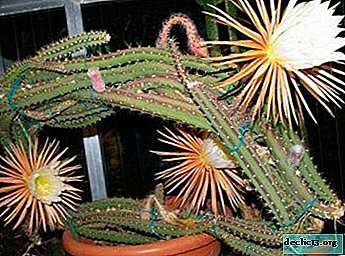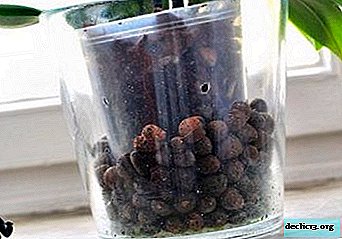Proper cultivation of the real “queen of the night” - selenicereus: how not to destroy the plant? Description of species and photos

Gorgeous, amazing, amazing, bewitching - it's all about her, about the queen of the night. Yes, yes, yes, you heard right - the queen! In a shady tropical forest of a distant continent, a plant of unusual beauty and a dizzying aroma lives, the flowers of which bloom exclusively at night and wither with the first glimmer. What is his name and why does his name make the heart tremble? The article will tell you about the intricacies of caring for a tropical treasure so that it can delight you with its splendor and become an adornment of the interior in the apartment or a cozy corner in the garden.
Botanical description and history
Selenicereus (lat. Selenicereus) is a genus of the Cactus family. Distributed in the tropics of Central and South America. It can lead lithophytic, epiphytic and terrestrial lifestyles. These large epiphytes differ from other types of ampelous succulents in their appearance (for species of cacti, read here).
- Firstly, it has very powerful and thin shoots, reaching a length of 5 and even 12 meters.
- Secondly, their surface is smooth and glossy, and small spines grow only in areoles.
- Thirdly, the flowers of selenicereus are striking in their sizes - up to 30-35 cm in diameter!
At first glance, they resemble water lilies, but their structure is somewhat more complicated and consists of numerous perianth, divided into dozens of external and internal lobes. The lobes can be needle or filiform, dark in color, creating a feeling of a double structure of the flower. Just appeared the buds consist of dense hairs, in the center of which there is another bee-bud.
The color of the petals can be different - brown, yellow, red, pink (about red cacti is described here, and about pink read here). Stamens are magnificent, strong. Air roots clinging to a support.
It is interesting! The name combines the two words "Greek" Selene "- the name of the moon goddess and Latin" cereus "- a candle. Different peoples gave it their names - Moonlight, Snake cactus, Dragon cactus, Blooming in the night.Popular species of Selenicereus: characteristics and photos
Large flowered (Grandiflorus)
This was the first species that fell into indoor culture, and is still considered the most reliable of all. 3-4 ribs are distinguished on long, upright shoots, and spines are rarely located and fall over time (are there cacti without spines?). The flowers are vanilla-white, with needle-shaped yellow sepals, exuding a pleasant smell of vanilla with a hint of jasmine. The buds open at dusk, one after the other, but hold only until the morning. After flowering, spherical fruits up to 9 cm in length are formed. They can be pink, orange, red and yellow.

Anthony (Anthonyanus)
Nickname "fish bone". Anthony's leaves are fleshy, leaf-like and resemble fish skeletons. The stems are flat, juicy, cut along the edges like oak leaves. Flowers have the brightest color of all existing species, have an average diameter (up to 20 cm). This species is often grown in ampelous culture, since the transitions of colors on its petals from dark to light simply amaze their tenderness.

Hooked (Hamatus)
Distinctive features: the numerous spiked setae covering it, the hook-shaped processes and ribs covering it. Inflorescences reach 20 cm in diameter and 40 in length. The internal perianth lobes are oval and wide. The shape of the flowers is a cup-shaped, light green color with golden stamens.

MacDonald (Macdonaldiae Britt.et Rose)
The external characteristics are similar to the view of Grandiflorus.
Reference! There is a unique cactus in the St. Petersburg Botanical Garden, which has been cultivated for almost 200 years - since 1824! Mrs. MacDonald's Selenitereus is the oldest greenhouse plant that survived both relocations, wars, and years of perestroika.The only difference is the orange color of the outer petals.

How to care at home?
Temperature
For the summer period, the ambient temperature should be at least 23 degrees Celsius. From October to the end of March - 10-15 degrees.
Watering
Abundant watering is required in the summer months. In winter, it is reduced to a minimum, only so that the cactus does not wilt. Water should be soft and clean at room temperature. Hard water can be softened by adding any natural acid.
Between watering the substrate should dry completely. Selenicereus does not need additional spraying, but from time to time it will be useful to wipe its stems from dust with a damp cloth.
Lighting
The cactus loves light, so you need to place it on the south window. Especially lighting is necessary during the rest period. But it is impossible to drastically change the lighting conditions, for example, to take out a plant growing on the east window under direct sunlight and leave for a long time. Otherwise, the plant will get burned.
Attention! The plant does not like artificial lighting and painfully reacts even not subtle fluctuations in lighting!The soil
As with any other plant the soil must be saturated with nutrients, good air and water. It will be enough to buy any mixture for cacti and succulents, and mix it with a handful of small expanded clay or broken brick.
Experienced gardeners are advised to add crushed charcoal to avoid root rot. You can make your own mixture by combining coarse sand with turf soil (2: 1), charcoal, vermiculite and fine expanded clay. Do not forget about drainage at the bottom of the pot! Selenicereus needs support for the shoots.
Pruning
 In terms of pruning, the plant requires increased attention. But this is done not for the density of the bush, but in the event that the stems have grown randomly and interfere.
In terms of pruning, the plant requires increased attention. But this is done not for the density of the bush, but in the event that the stems have grown randomly and interfere.
- Trimming is carried out with disinfected tools.
- No more than 3 shoots are cut off at a time, otherwise ugly stumps will remain.
- Sliced areas are dusted with activated carbon.
- If the shoot was injured during pruning, immediately cut the stem below the site of damage.
- The tips do not need to be pinched.
Top dressing
From March to October, cactus is fed with universal fertilizers for cacti. This is done 2-3 times a month. You can’t fertilize during the wintering period.
Transfer
- Young cacti are transplanted annually, adults - as necessary, for example, in case of illness.
- A suitable season is spring.
- The new pot should be 1.5 2 cm wider than the previous one. A powerful, high drainage is laid in it.
- In an adult plant, it is necessary to clean off the top layer of the old substrate (until the roots appear) and pour a new one.
Wintering
Wintering falls in the winter months. The room temperature must necessarily be lowered, otherwise the stems will thinn and stretch. Sharp night cooling and drafts should not be allowed.
Features of outdoor care
To plant a cactus, you need to choose large, stable containers - for example, flower tubs. It looks good in compositions with other deciduous or flowering plants.
Step-by-step instructions for reproduction by shoots and seeds
Propagation by seed:
- Seed material is taken only freshly picked.
- Before planting, you need to wrap it in a damp cloth and hold it for a day in a dark, warm place.
 After disembarkation, the container is covered with glass or cling film and placed in a lit place. The temperature in the room should be at least 20 degrees.
After disembarkation, the container is covered with glass or cling film and placed in a lit place. The temperature in the room should be at least 20 degrees.- Shoots appear after 3 weeks.
Propagation by cuttings is used more often than seeds:
- Cuttings are cut from a young plant. The required length is from 5 to 10 cm.
- Before planting, they dry the day in the sun.
- After rooting in the ground, the container is placed in a place illuminated by heat.
Street cultivation
The conditions for growing and propagating in open ground are identical to the conditions of the room.
Bloom
Selenicereus flowers are the largest among all Cactus species. In some species, they can reach a diameter of 40 cm. Prefers to bloom in spring. Over the entire period can produce up to 50 buds. But this requires conditions close to ideal.
What to do if it does not bloom?
The cactus refuses to bloom if the conditions of detention have been violated: it lacks light, the owner irrigates the plant too hard, or the humidity level in the room is too high. You can correct the situation by moving the pot to a suitable place and reducing the amount of water.
Diseases and Pests
Most often, selenicereus affects fusarium. Reddish-brown patches appear on the roots, covered with a whitish bloom. Gradually clogged vessels that conduct water, resulting in disrupted photosynthesis and water metabolism. The stems turn yellow, the buds fall, not blossoming. Adult plants die quickly, while in young ones the symptoms are not so pronounced.
The disease can occur in the following cases:
- If the room is hot (above 30 degrees).
- The pot stagnates water.
To treat this dangerous fungal disease, Trichodermin is well suited. Treatment regimen:
- Pull the plant out of the pot.
- Remove excess land.
- Rinse in the prepared solution (5 g of powder is dissolved in 5 liters of water).
- Transplant into a new pot with fresh substrate.
 For lack of Trichodermin, you can buy Bactofit, Vitaros, Fitosporin-M.
For lack of Trichodermin, you can buy Bactofit, Vitaros, Fitosporin-M.
A spider mite is an equally dangerous enemy of a cactus. It is extremely difficult to discern it, but the harm from it is enormous: adults and larvae suck juice from the plant, destroying it in just a couple of weeks. In addition, these insects are carriers of pathogens and harmful bacteria. If the plant is all covered with cobwebs, it is too late to save it. For the rest, the following tools are suitable:
- Biological products Akarin, Bitoxibacillin, Fitoverm - well cope with adults, but do not act on larvae.
- Pesticides flufenzin and clofentesin - sterilize the uterus, preventing the appearance of new ticks.
- Folk remedies - chopped garlic, laundry soap, infusion of dandelion roots, onion broth.
Similar plants
Selenicireus has an external resemblance to epifellum, yellow-stem marnier, cryptocereus, aporocactus, nopalksokhia.
Conclusion
Selenicereus is considered a unique plant even against the background of other representatives of the Cactus familyno less beautiful and brightly blooming. More and more gardeners bow their heads in admiration for this overseas exotic. Although it is not easy for the selenicereus with its large-sized shoots to find a cozy corner in the house and create optimal conditions for development, and breathe the aroma of lush flowers in just one night - it is worth all the effort.

 After disembarkation, the container is covered with glass or cling film and placed in a lit place. The temperature in the room should be at least 20 degrees.
After disembarkation, the container is covered with glass or cling film and placed in a lit place. The temperature in the room should be at least 20 degrees.















